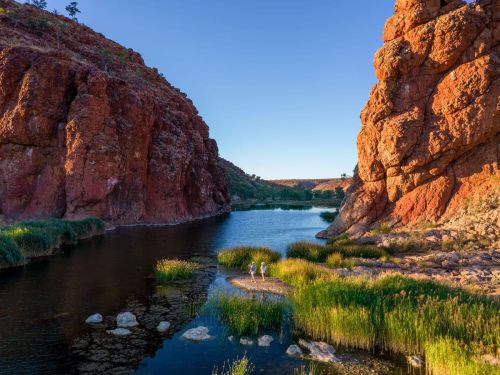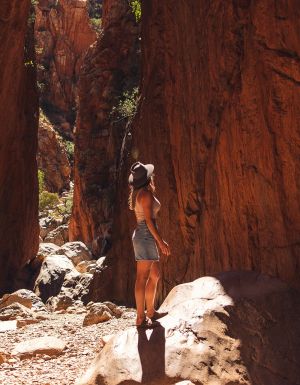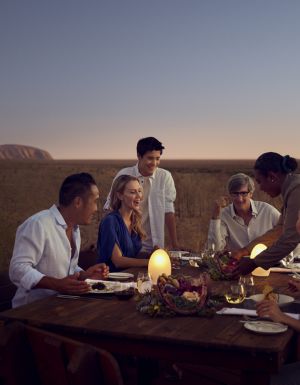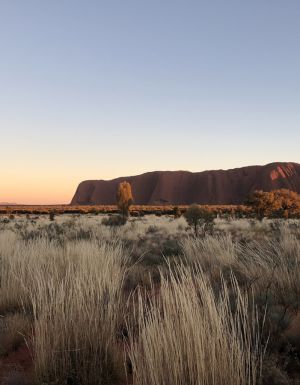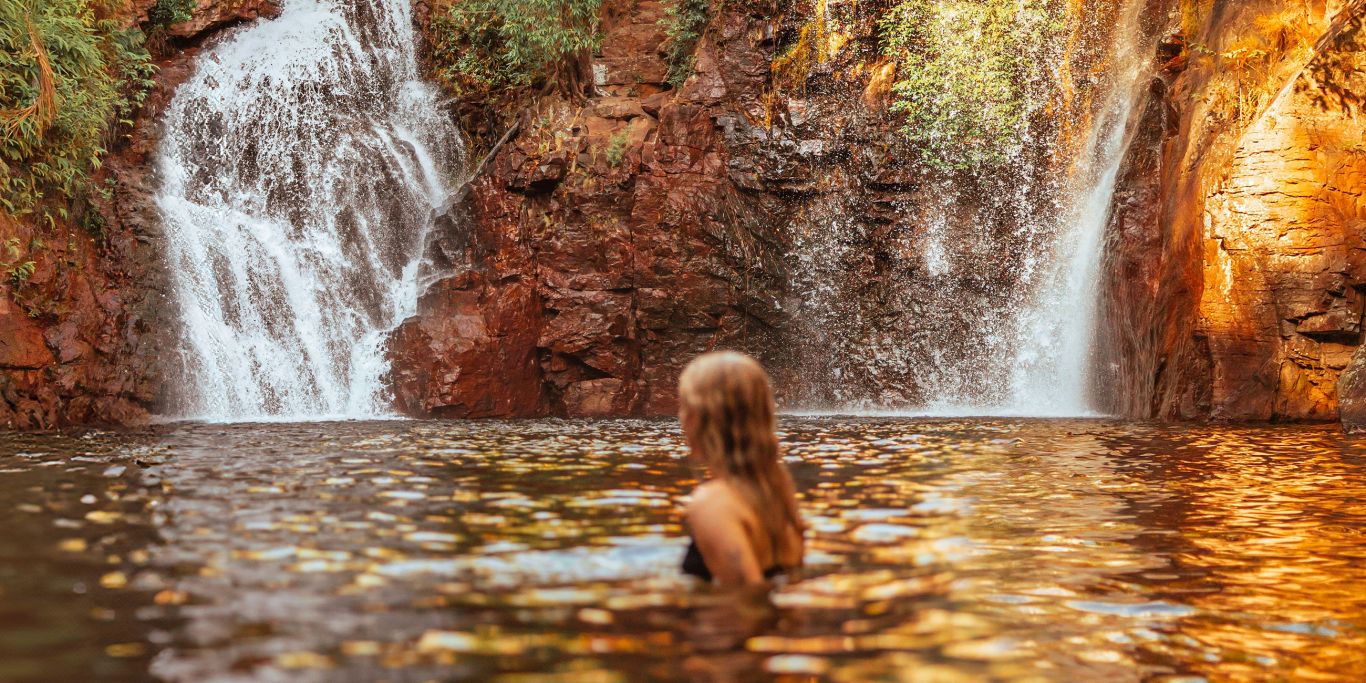The immense Tjoritja/West MacDonnell National Park boasts some of Central Australia’s most spectacular scenery.
Stretching for 160 kilometres west from Alice Springs, its concentration of pristine waterholes, cliffs of colourful ochre and biodiversity is hard to match. Best explored on foot, it’s home to the epic 223-kilometre Larapinta Trail, one of Australia’s most challenging multi-day walks. But you don’t have to commit to the entire length of this iconic line to experience the valleys, plains, and canyons of the West Macs. Here’s your ultimate guide to exploring the West MacDonnell Ranges.
How to get to West MacDonnell National Park
The West Macs begin just outside Alice Springs, with the major attractions ranging from 15 minutes to 2 hours’ drive away. Jump on an organised tour or hire your own car to access the sites.

While a regular car will get you to many of the major sites, a 4WD will allow you to do side trips. Another way to experience the West Macs is to hike a section of the Larapinta Trail .

What to see in West MacDonnell National Park
Must-see spots include Simpsons Gap with its towering red cliffs and black-footed rock wallabies, Ellery Creek with its refreshingly cool (bordering on icy) swimming hole, and Standley Chasm with its glowing red rock walls at midday. The historical Ochre Pits are well worth a visit, as is the natural oasis that is Ormiston Gorge and Glen Helen with its huge cliff face and inviting cool water.

Simpsons Gap
Only a short drive from Alice Springs, the towering red cliffs of Simpsons Gap are unmissable. If you’re here at sunrise or sunset, keep your eyes peeled for rock wallabies near the walking paths. The area is also a nature lover’s dream, dotted with ghost gums, mulga trees and over 40 kinds of rare plants.

For the walkers, there are several easy trails to pick from that wind through native plants with some pretty sweet views of the ranges thrown in. If biking is your thing, there’s a 17 kilometres path from just outside Alice Springs straight to the Gap. Outback Cycling rents out bikes. Make sure you pack plenty of cold drinks as it’s the only refreshment permitted here. No swimming is allowed.

Standley Chasm
Owned by the Western Arrernte people, Standley Chasm is an incredibly narrow, soaring passage through the towering, rust-stained rocks, just a 40-minute drive west of Alice Springs.

To access this 80-metre high, three-metre-wide canyon you will need to purchase a $12 ticket to enter this flora and fauna reserve. From the kiosk, it’s an easy 1.2-kilometre walk along a well-maintained path to the gorge. For a more in-depth experience, jump on a half-day cultural experience, which includes a guided walk, dot painting workshop and lunch.

Ellery Creek Big Hole
You’ll find this secluded swimming spot 88 kilometres west of Alice Springs. With easy access via a sealed road, this permanent, deep waterhole surrounded by towering red cliffs is perfect for a dip on a hot day. If you’re lucky you might spot a dingo taking a drink, and keep an eye out for honeyeaters, white-winged fairywrens, and little buttonquails. Hikers can set off on the Dolomite Walk, a three-kilometre loop walk through the surrounding spinifex country with good views en route.

Serpentine Gorge
The narrow, ochre-red Serpentine Gorge sits 100 kilometres west of Alice Springs, with the entrance to the gorge down a three-kilometre dirt track. It has a little waterhole, a dwarf compared to surrounding waterholes, but its lookout adds to its appeal. Climb up the steep track for about 15 minutes to the top of a towering cliff and (once you catch your breath back) you will be stunned by the 360-degree view from the top.
Ochre Pits
About 110 kilometres west of Alice Springs, don’t miss stopping by the spectacular Ochre Pits, a rockface with colourful bands of clay. The Ochre Pits are easily accessible via a 300-metre sealed path from the car park, which is an attractive picnic spot. The Western Aranda people have used this site for thousands of years to gather ochre for painting, body decoration, medicine, and to cover wooden weapons to protect them from termites.

Glen Helen Gorge
Glen Helen is your go-to spot for soaking in the majesty of the West Macs, enjoying a swim, and hanging out with the local fauna.

Sitting 132 kilometres west of Alice Springs, the first thing you see as you drive into Glen Helen is a towering sandstone cliff. A short stroll from the car park, you will find a serene hideaway with shaded banks and a huge body of water that is home to several fish species.

Ormiston Gorge
A huge inviting pool surrounded by sandy verges, Ormiston Gorge is another unmissable spot, famously swimmable year-round.

To earn your refreshing swim you should attempt the 8.5-kilometre Ormiston Pound Walk (a loop hike from the car park). It takes you to a ridge-top lookout over Ormiston Pound, a circle of peaks amid the otherwise unbending lines of the West MacDonnell Ranges.

Redbank Gorge
Nestled at the base of Mt Sonder, Redbank Gorge is a slot canyon with a near-permanent waterhole that is a bird-watching paradise. Tip: bring a flotation device to swim through the gorge.

There are plenty of hiking options at Redbank Gorge, 156km west of Alice Springs. Hikers can tick off Larapinta Trail’s section 12 from the car park, a 5km return walk that takes you to the Mount Sonder Lookout.

West MacDonnell Ranges Accommodation
Camping spots are plentiful in the West Macs and are managed by NT Parks, except for Standley Chasm. Make sure you book at NT Parks before you arrive and plan several months in advance as sites book out during the peak winter months.

Standley Chasm
At the Aboriginal-owned and operated Standley Chasm campers and caravaners can choose from powered and non-powered sites on the grassy lawn.

Facilities include toilets, hot showers, a washing machine, a camp kitchen, and barbecues. There’s also a kiosk cafe and gift shop.

Ellery Creek Campground
At the popular Ellery Creek Big Hole, you’ll no doubt be sharing this beautiful swimming spot with others. Tents, trailers and caravans are welcome at the campground and facilities include barbecues, wood firepits and toilets.

Ormiston Gorge Campground
Pleasant camping facilities are available at Ormiston Gorge, 135 kilometres west of Alice Springs. Facilities include gas barbecues, toilets, and showers.

Birthday Waterhole Campground
Accessible by 4WD only, Birthday Waterhole is about an hour’s drive from Alice Springs. There are no facilities so make sure you have drinking water and all your camping requirements with you.
Finke River Two Mile Campground
Accessible by 4WD only, Finke Two Mile campground sits beside the Finke River, around 130 kilometres west of Alice Springs. Campers need to be self-sufficient as there are no facilities here.

Redbank Gorge (Ridgetop) Campground
The tranquil Redbank Gorge (Ridgetop) campsite has basic facilities including toilets, firepits, and picnic tables. A 4WD is recommended to access this gorge, which is 156km from Alice Springs and 5km along a dirt road.



